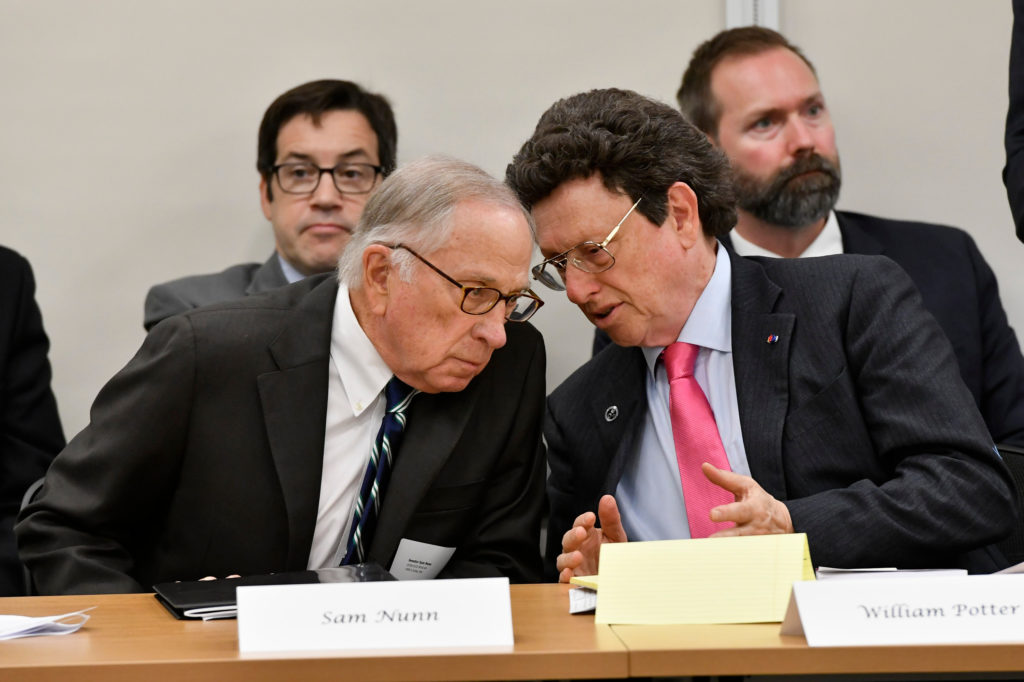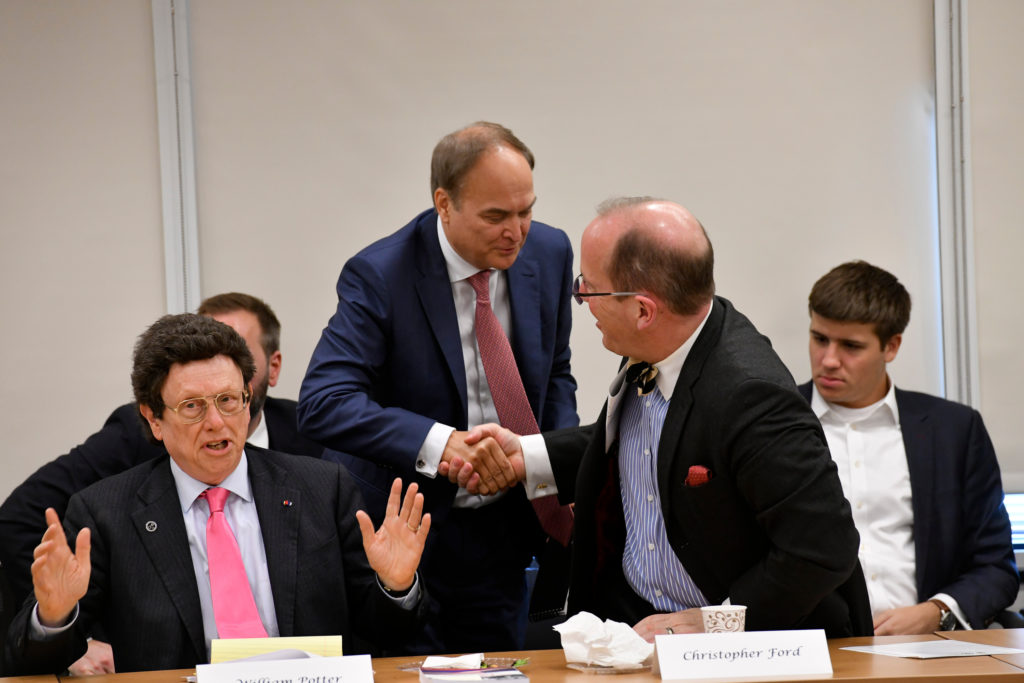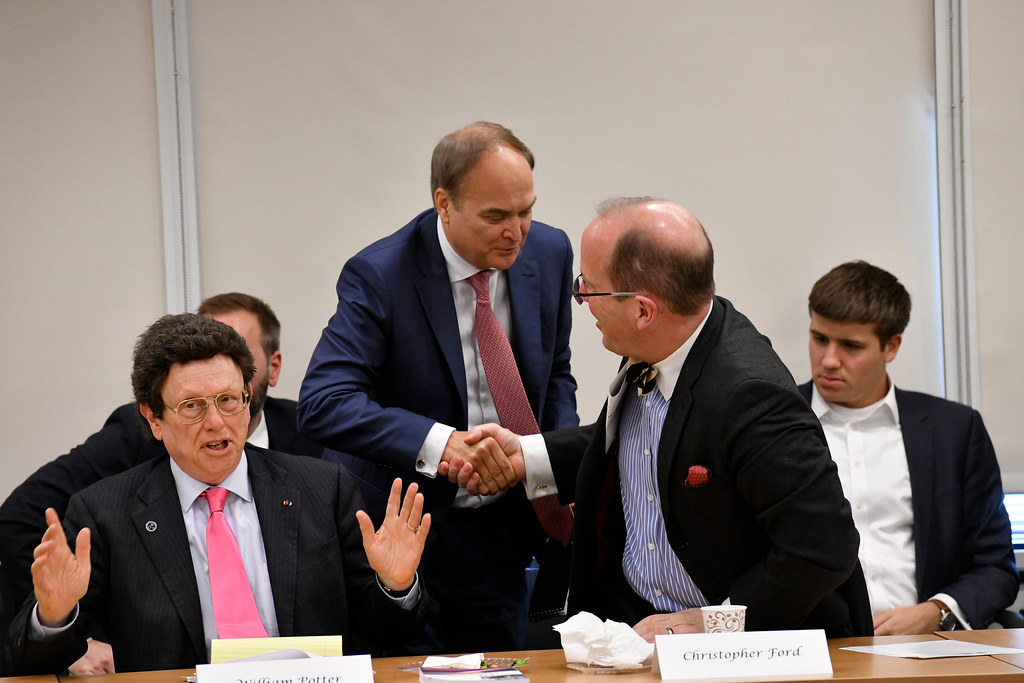November 5, 2018
On Monday, October 22, 2018, the James Martin Center for Nonproliferation Studies (CNS) convened the annual meeting of its International Advisory Council (IAC) at the CNS office in Washington, DC. This event provides an opportunity for Council members and invited guests to learn more about the Center’s recent work and what it has planned for the future. Because most of the individuals who comprise the IAC have devoted their professional lives to preventing the spread of weapons of mass destruction, this meeting invariably stimulates a lively and informed exchange of views across a range of topics. This year was no exception.

Bill Potter and Senator Nunn
The 2018 meeting began with a discussion of new initiatives. This panel featured Sarah Bidgood, senior research associate and project manager at CNS, Ambassador (ret.) Laura Holgate, vice president for materials Risk management at the Nuclear Threat Initiative, and Ambassador (ret.) Susan Burk, former special representative to the US president for nuclear nonproliferation. The three speakers briefed the audience on CNS’s Young Women in Nonproliferation Initiative activities, the coordination of a Champions in Nuclear Policy group, and the importance of mentorship in addressing the gap in this field, respectively. Attendees unanimously welcomed these efforts, prompting a number of them to reflect upon the difference they would have made in their own careers.
Illustrating the importance of engaging new voices in nonproliferation, arms control, and disarmament, the next panel featured presentations by recent MIIS alumna and CNS research associate Anne Pellegrino and Middlebury College undergraduate and former CNS intern Octave Lepinard. This session showcased Ms. Pellegrino’s research into recent developments at the Soviet nuclear test site, Novaya Zemlya. It also highlighted the potential for readily available satellite imagery to facilitate greater transparency and confidence building between the United States and Russia at a time when relations are in a state of crisis. Following her remarks, Mr. Lepinard described how he used satellite imagery to map the landscape of uranium-enrichment activities in North Korea, tools he acquired as a geology and computer science double major and refined during his summer internship at CNS.[1]
A third panel—entitled “Dirty Little Lies: The Rise, Demise, and Possible Future of Radiological Weapons Programs”—used more traditional approaches to analyze the challenges posed by radiological weapons—weapons usually thought of mainly in the context of non-state actors. CNS Director William Potter and Research Associates Sam Meyer and Sarah Bidgood reported on the history of state-level radiological-weapons programs in the United States and Soviet Union and derived lessons from these programs relevant to possible future proliferators, including alternative deterrent strategies. One intriguing approach discussed involves revisiting the draft US–Soviet radiological-weapons convention that was introduced to the Conference in Disarmament in 1980 but never adopted. Such a multilateral approach might contribute to strengthening the disarmament architecture while also enhancing US–Russian nuclear cooperation.

Inga Yumasheva and Senator Nunn
The dire need for such collaboration was highlighted by lunchtime addresses delivered by Russian Ambassador to the United States Anatoly Antonov and US Assistant Secretary of State Christopher Ford. Their comments about the dismal state of arms control and nonproliferation underscored the distance between Russian and American positions on a host of important issues, including those that previously had been the subject of close collaboration, even during the height of the Cold War.
A subsequent panel discussion on “Once and Future Partners: The United States, Russia, and Nuclear Nonproliferation” provided little grounds for optimism, although the four featured speakers identified a number of areas where convergent US and Russian interests could lead to constructive engagement. Ms. Inga Yumasheva, member of the Russian Duma, proposed how parliamentarians in Washington and Moscow might initiate a dialogue to explore common nonproliferation and arms-control objectives, while former Senator Sam Nunn, co-chair of the Nuclear Threat Initiative Board of Directors, provided five concrete suggestions for averting nuclear catastrophe and shoring up strategic stability. Dr. Vladimir Orlov, founder of the PIR Center, emphasized the value of education and training and pointed to the success of his Center’s work and that of CNS in building a cadre of new US and Russian experts in the nonproliferation sphere. For his part, Mr. Tom Blanton, executive director of the National Security Archive, focused on the need to be more attentive to past, troubling episodes in US–Soviet nuclear relations in order to avoid their recurrence and restore habits of nuclear cooperation.
The main focus of the International Advisory Council business session also dealt with US–Russian relations and ways in which the comparative advantage of CNS and the Middlebury Institute in this area—including the MIIS-MGIMO Dual Degree, collaborative nuclear research and dialogue activities, and the Graduate Initiative in Russian Studies—might be further advanced. The discussion benefited from the active participation of President Laurie Patton, several foundation representatives, and CNS council members.

Ambassador Antonov and Secretary Ford
While much of the day was focused on Russia, in the evening attention shifted to the Korean Peninsula and Dr. Jeffrey Lewis’s new “speculative novel,” The 2020 Commission Report on the North Korean Nuclear Attacks Against the United States. In an interview over dinner with former CNN correspondent and news anchor Frank Sesno, Dr. Lewis described his motivations for writing the book, what he learned in the process, and—most disturbingly—the thin line between fiction and reality. Like the rest of the day’s discussions, Dr. Lewis’s reflections drove home the looming risks of nuclear exchange and the imperative of nuclear-risk reduction.
In sum, the fall 2018 International Advisory Council meeting showcased the diverse tools, including language skills and the application of new “open-source” technologies CNS experts use to analyze and make recommendations about pressing WMD-related challenges. It also highlighted the Center’s convening power and ability to interact and communicate effectively with a wide range of stakeholders, including senior policy makers, other experts and educators, representatives of the press, and the general public. While it is unlikely that many attendees went home feeling optimistic about the state of global affairs, hopefully they were reassured that CNS will continue to devote its resources to making the world a safer one.
[1] Mr. Lepinard’s work is showcased in two recent CNS Occasional Papers he coauthored, “Geo4Nonpro 2.0” and “Monitoring Uranium Mining and Milling in China and North Korea through Remote Sensing Imagery.”

